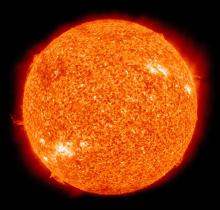Listen to today's episode of StarDate on the web the same day it airs in high-quality streaming audio without any extra ads or announcements. Choose a $8 one-month pass, or listen every day for a year for just $30.
You are here
Martin Ryle
Astronomers are developing bigger and bigger arrays of radio telescopes. By combining the signals from dozens or hundreds of antennas, they can produce extremely sharp images of the universe — far more detailed than possible with any single telescope.
That technique was pioneered by British astronomer Martin Ryle, who was born 100 years ago today.
After earning a degree in physics from Oxford, Ryle helped develop radar during World War II. After the war, there was lots of surplus military radar equipment. So Ryle put some of it to work to study the universe.
He first looked at the radio waves from the Sun and nearby stars. But it takes huge telescopes to produce detailed radio images. Ryle realized, though, that you could do the job by combining signals from two or more telescopes. The farther apart you placed the telescopes, the more detailed the observations.
Using this technique, Ryle and his colleagues compiled an extensive map of the radio sky.
Ryle and a colleague shared the 1974 Nobel Prize in physics — the first Nobel awarded specifically for astronomy.
Ryle thought radio astronomy should be limited, though. When astronomers used a giant radio dish to beam a message into space, he complained that it could lead to an alien invasion. He urged his colleagues to maintain radio silence — to use their telescopes to listen to the universe, not talk to it.
Script by Damond Benningfield





